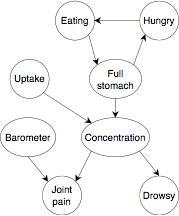May 22, 2004
Continuous Time Bayesian Networks (More info)
A CTBN factors the state space much like a Bayesian influence diagram. The image above shows the graphical model which describes the independencies in a particular domain related to drug response. In the CTBN paradigm, cycles are allowed. This is due to the fact that all influence is considered to occur over time however infinitesimal that amount of time may be. So, for example, in the diagram on the left, the cycle at the top of the diagram would be interpreted from a DBN perspective as Eating_N -> FullStomach_N+dt , FullStomach_N -> Hungry_N+dt , and Hungry_N -> Eating_N+dt. Because the influences are factored, each influence arrow A->B has a different CIM for each joint setting of the parents of A.
One of the best motivations for creating this paradigm is because in one calculation it is possible to exactly infer the distribution over the state of the HMP without higher frequency updates. So given a distribution over the state at time T, the distribution over the state at time T+s can be calculated directly in one step regardless of the value of s. This answers one of my questions about how reasoning could be done more efficiently than a DBN which I raised in my review of A Closed-Form Solution for Mapping General Distributions to Minimal PH Distributions
Another question I had about this technique was: What happens if you query the state of the system at a very large time in the future? The authors confirmed my suspicion that the distribution always tends toward the "prior" which in this case is called the "stationary distribution."
The first approximate inference algorithm that was proposed for CTBNs, the "Linearization Method", basically assumed that the exponential distributions were linear and that the values of the random variables didn't change between updates. This is funny because it basically means that this inference method is only valid over short time intervals, exactly the problem that CTBNs were supposed to improve over DBNs! The second inference algorithm, the "Sub-System Method", seemed inconsistent. Sometimes it worked well in the short-term and sometimes it worked better in the long-term. All of the approximate methods did better with frequent updates, whether artificially induced or due to the presence of observations.
So my conclusion is that this is a step in the right direction because it explicitly models continuous time. I like the elegance of the method and the possibility of modeling more complicated distributions than exponentials through combinations of exponentials. I think it's premature though to say that it is clearly a better approach than DBNs. It certainly appeals to a mathematical sense of being the "right" way to reason about time in a Bayesian model, but the experiments don't seem to conclude that CTBNs have fixed the problems that DBNs have.
Posted by djp3 at May 22, 2004 06:30 AM | TrackBack (0)Hi Don,
First up thanks for reading and writing up your comments on the paper - they've definitely helped me think some things through much better. Here are a few observations:
1) About the question of making queries over long time frames - Clearly, in any time-varying system, it is natural that our confidence in what the system is doing very far into the future must necessarily be low. The question that I think is interesting is how far into the future can we be reasonably confident about our estimates of the system state. With purely exponential distributions, my intuition is that this time frame is quite small compared to what we would get if we were modeling more general distributions, the reason being the e^-(bt) in the exponential. This would cause our probability distribution to tend to the stationary distribution really quickly. The hope with the EC distribution is that we're able to extend the time it takes for our belief to tend to the stationary distr., while still being able to make reliable estimates of the state.
2) As far as the inference goes, I was not really impressed with the results they were getting, even on their toy domain for the same reasons that you weren't either. I'm surprised they did not try sampling based inference with particle filters, which is the approach we want to try. It seems fairly straightforward to adapt particle filtering on CTBNs to handle updates when we get observations. Of course, there's still amt. of work to be done in fleshing out details. Let's see how it goes.
Please let me know what you think.
Thanks!!


